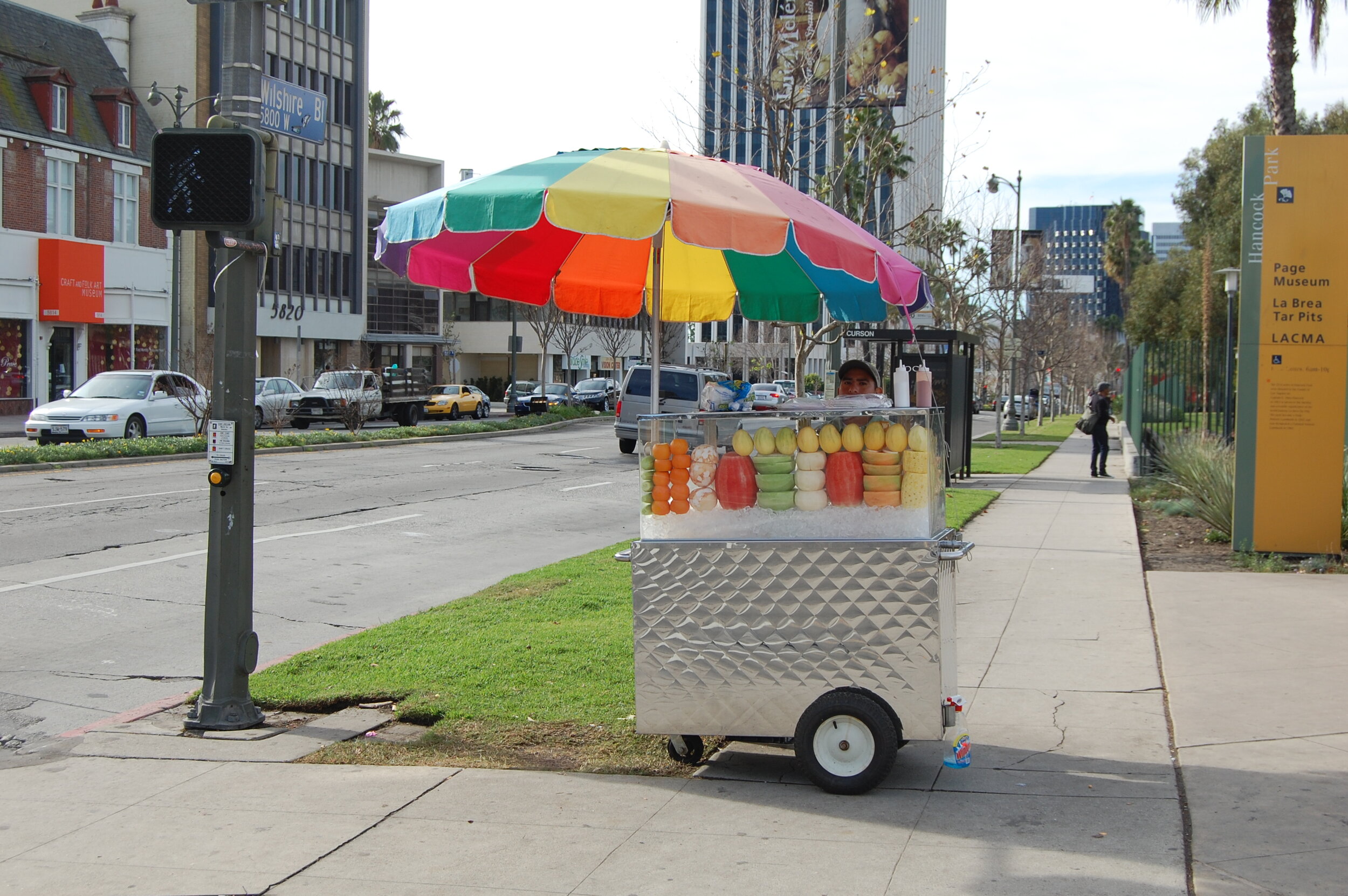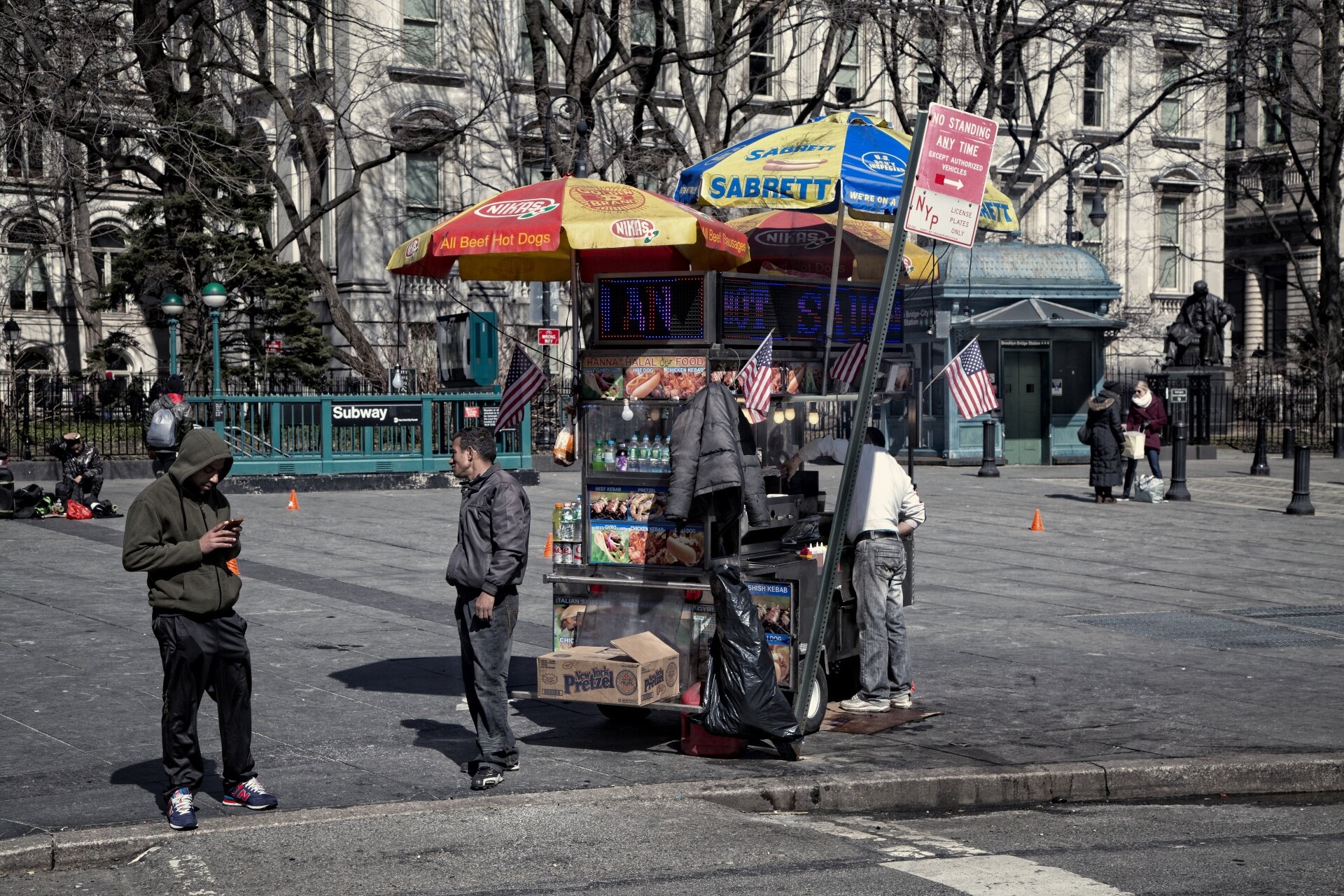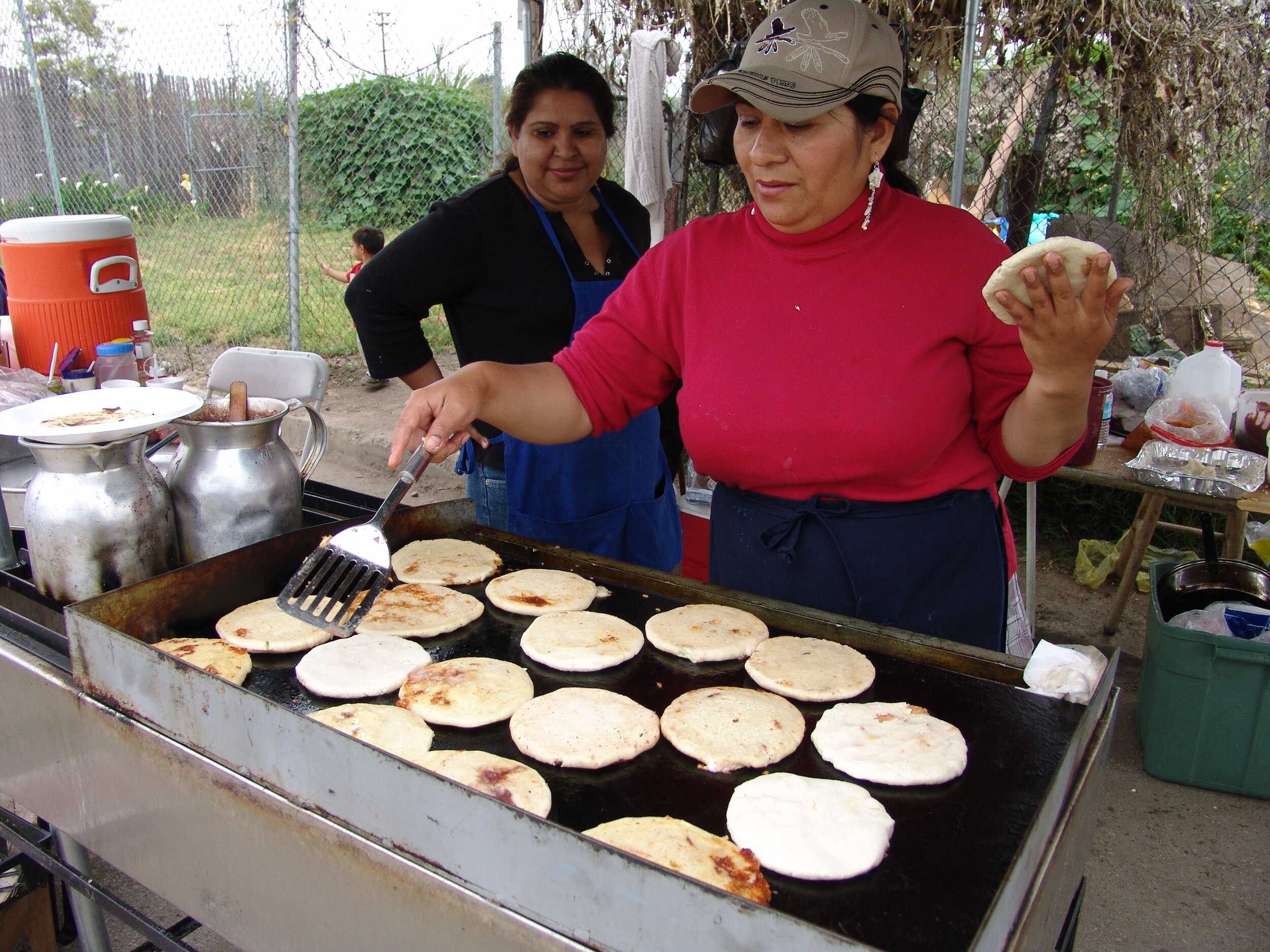Best of 2020: Street Vendors Are Vital Local Businesses. Cities Need to Do More to Support Them.
One simple test of a strong town or city is the following: is it a place where you can start with nothing and end up with something?
Resilient local prosperity begins when residents are able to take the next, best small step to improve their home, their business, or their neighborhood, and they ought to be able to do that small thing right away with minimal friction. In housing, for example, this might mean building an addition, a backyard accessory apartment, or a tiny house. In transportation, it means testing out a street safety concept with a bit of temporary tactical urbanism. And in the food world, it means it should be easy and accessible to open and operate a street cart or food truck—the first incremental step from which a successful entrepreneur may one day want to graduate to a brick-and-mortar restaurant.
Yet our cities aren’t nearly supportive enough of these smallest of small businesses. We tend to bog them down in red tape and well-intended rules, in an attempt to impose too much order on an urban landscape in which we truly need to tolerate a little chaos. This is exemplified by a you-can’t-make-it-up headline from this June, in which Los Angeles proudly announced that street vendors could now legally participate in the city’s COVID-inspired outdoor dining program. That is, the 48 street vendors actually holding all the right licenses (which are costly and confusing to obtain), not the 10,000 that didn’t.
In this crucial pandemic year, life moved outdoors and America’s cities bent over backwards to accommodate the resulting necessary shifts for brick and mortar restaurants… but haven’t done nearly as much for their smaller and more improvisational cousins. That’s a shame, because a city that doesn’t just allow but welcomes hundreds of small experiments to shape its streets is ultimately going to be a city that is more fair, more prosperous, and more exciting. — Daniel Herriges, Senior Editor
Street food in Los Angeles. Image credit: Flickr user Ben Christen
It's conventional wisdom that if you want people to show up somewhere, make sure there's food. We're not very good at this trick in our cities, though. Americans who travel abroad often remark upon the ubiquity of street carts, stands, and trucks selling food. On the sidewalks, in the plazas, in the parks of thousands of cities across many societies. The best human places are teeming with food—and it's no wonder, since the quest for reliable food is no less than the driving force of all civilization.
Americans have caught on to the appeal of this, but haven't yet proven ourselves comfortable with the level of informality and spontaneity required to have a culture of street food. Instead, the common experience here seems to be that you go to a sit-down restaurant and order a $14 appetizer bafflingly called "Street Tacos." Meanwhile, down the street, the cops hassle an actual street taco seller for not having the right permits.
Now's a good time to get more comfortable, and adjust our regulations and practices accordingly. It's ideal because we're already in a period of flux where many are rethinking how streets should function.
The push to open streets to dining and socializing in the coronavirus pandemic has been a boon to American cities. Not only has it helped some businesses hang in there, but it's also prompted a re-evaluation of what streets are for. The street is not simply for moving people along (let alone just motor vehicles): the timeless historic function of an urban street is to be a platform for building a productive place.
In plain English: the street is where life happens. It's where we do stuff. And perhaps especially so when fresh outdoor air which hasn't been recirculated, viral particles and all, through any sort of HVAC system increasingly appears to be a vital part of keeping us healthy.
In a superb July op-ed in Streetsblog USA, John Rennie Short, a professor in the School of Public Policy at the University of Maryland, Baltimore, argues for the value of including street vending in cities' COVID-19 responses.
[Street vending] enlivens urban public spaces and increases public safety by making streets vibrant and welcoming, Promoting street vending can generate employment, keep people safe and create the vitality and comity that is the hallmark of livable humane cities.
As Short describes, street vending is big business: "More than 2 billion people worldwide—over half the planet’s employed population—work in the informal economy, mainly in developing countries." Don't let the word "informal" (which in economist-speak just means operating outside of some regulatory institutions) fool you: these are often savvy business people running careful operations on razor-thin margins, and the money that flows through this sector is a lifeline to people who can't find work or earn adequate wages in the formal economy.
America's coronavirus response has generally failed to do much good for street vendors, where it hasn't done outright harm. These are people who are particularly economically vulnerable in the pandemic, often operating on slim margins, and they're also a vital and integral part of the places we allow them to be.
Unfortunately, "where we allow them to be" and what we allow them to do are extremely circumscribed in North American cities compared to, well, most of the world. Here are several ways we make life hard for street vendors compared to entrepreneurs higher up the food chain—and how people are working to change that.
Los Angeles
Fruit cart in Los Angeles. Image credit: Flickr user stu_spivack
LA may be the capital of street vending in the United States, with its strong Latin American influences contributing to a longstanding culture in which you can buy a lot more than just food from a sidewalk cart. The city decriminalized street vending in 2019—sort of. The change has been rife with problems, some of which I wrote about in a piece earlier in 2020. These problems range from unclear rules and high fees and penalties, to hearings in which no translation was available for Spanish-speaking vendors.
As described by Streetsblog LA in March:
A lengthy letter sent to city council last month by the Los Angeles Street Vendor Campaign (LASVC) had detailed just how many barriers to permit access had been built into the system and warned that requiring compliance with such a system could keep vendors from being able to practice their trade. Not only had the rollout, administration, and enforcement of the program been inadequate, haphazard, confusing, and punitive the letter explained, the permitting process itself was prohibitively costly, required equipment that was unavailable (or inaccessible) to vendors, and hadn’t been adapted to reflect how family businesses operated in L.A. (e.g. requiring each person be individually permitted, adding to their cost burden), among many other things.
The pandemic has only worsened the situation. When LA issued its first shelter-in-place orders in March of 2020, they included an effective moratorium on all street vending. But when the city allowed restaurants to reopen and instituted a sidewalk dining program to help them remain viable, street vendors were left out in the cold. As the LA Times's Lucas Kwan reported in June,
On Friday Mayor Eric Garcetti launched his “L.A. Al Fresco” initiative to provide restaurants cost-free permits to use public spaces such as sidewalks and private parking lots — but he did nothing to address street vendors’ rights to conduct business.
And this negligent, hypocritical farce endangers one of the most valuable — and certainly one of the most vulnerable — populations in our food community. Restaurants were able to apply for loans and grants from the government, but street vendors, who number 50,000 by some estimates, have received no such lifeline.
Not only did the Al Fresco initiative not make accommodations for street vendors, the city continues as of this summer to exercise stepped-up enforcement against street vendors for serving food on public sidewalks and parking areas.
Under criticism, Garcetti did move to allow street vendors to participate in LA Al Fresco—nominally anyway, resulting in this you-can’t-make-it-up headline in LA Eater at the end of June:
Mayor Says Licensed Street Vendors Can Now Participate in LA’s Outdoor Dining Plans
Out of 10,000 street vendors across LA County, the 48 holding licenses can now sell legally again.
No, you’re not misreading that number. That’s one-half of one percent of LA’s street vendors who are fully permitted under the city’s cumbersome and costly licensing program.
In the absence of more support from the city, local nonprofit Inclusive Action has launched a Street Vendor Emergency Fund to provide cash assistance in the form of $400 grants to these vulnerable businesses—825 of them as of early July. In addition to small donations, the program has received support from the United Way and the Disney Family Foundation. But it is still a drop in the bucket compared to the overwhelming need.
New York
New York City also has a rich tradition of street vending that doesn't always have the support of authorities—and that is suffering greatly right now with the loss of many of the office workers who used to commute into Manhattan and patronize street carts at lunch. Approximately 20,000 New Yorkers sell food and merchandise from the city's streets and sidewalks, contributing $293 million annually to the city's economy. But this number is likely far less than would be the case if the practice weren't regulated so harshly.
The number of licenses available for street vending has been tightly limited since the early 1980s to only about 3,000 citywide. Meanwhile, New York City approved over 4,000 brick-and-mortar restaurants for outdoor dining service in only four days, as was observed in late June by activist Dr. Debbie Almontaser.
The situation has led two city council members, Margaret Chin and Carlos Menchaca, to call in late July for measures to protect NYC's street vendors, including but not limited to:
Launching a small-business grant program for street vendors,
Identifying more open street spaces for vendors who cannot sustain their businesses in their usual location due to the loss of foot traffic,
And, finally, ending the longstanding permit cap that has forced vendors to operate in an exploitative underground market by passing Intro 1116 — a bill that would expand the number of permits to vend food on the streets and sidewalks and create a dedicated vending law-enforcement unit, which would exclusively enforce vending laws — as soon as possible. This is one tool that the administration has been sitting on for years — but could take up right now. There’s no reason to wait any longer. By passing this bill, the city would not only release new permits for street vendors to work legally for the first time in almost 40 years, but also codify the removal of NYPD from enforcement.
Street vendor in New York City. Image source.
In New York as in Los Angeles, nonprofits have stepped in to provide aid to the smallest of small businesses where government aid programs are unavailable or a poor match for their situation. According to Oscar Abello, writing in NextCity,
One by one, the staff at the Business Center for New Americans has been calling each of their 700 or so active borrowers, checking in on all of them during the unprecedented economic fallout from COVID-19. The nonprofit makes loans to street vendors, bodegas, ethnic grocers, restaurants, delivery truck companies, taxi medallion owner-drivers and other refugee-, immigrant- and woman-owned businesses around New York City. They started calling even before the order came to close down bars and restaurants for dine-in customers in New York, as people were already starting to participate in social distancing to help slow the spread of the virus.
Chicago
In Chicago, as the Chicago Tribune reports, local youth justice organization Increase the Peace is providing $500 grants to street vendors during the pandemic and is asking the public to donate to the cause. The organization has set an initial goal of $65,000. Vendors can apply for the grant here.
In early August, Streetsblog Chicago profiled several street vendors continuing to do business in the city despite the challenge posed by the pandemic. These profiles capture how street vendors are not anonymous, itinerant figures, but often known and integral members of a neighborhood’s local business community. Here is one example:
Tomas Hernandez, better known in the Avondale community as Jimmy, has run his tamale and elotes stand called Jimmy’s Tamales for over 10 years in the neighborhood. Before the pandemic, he would get about 120 customers a day and easily make over $130 dollars per day, enough to make rent, pay his bills and support his family. Now, he said the pandemic has thrown a wrench in his livelihood and he is down to about 60 customers on a good day.
[…]
Originally from El Salvador, Hernandez has lived in Avondale for 15 years and is part of the community fabric. Hernandez is in a new mural painted on a nearby vacant building that used to be home to a local grocery store. The work, called the Blue Goose Mural, pays homage to the vibrant immigrant community that built Avondale.
In addition to the regulatory obstacles faced in LA and New York, the article describes Chicago street vendors as complaining of unsafe conditions from drivers speeding down the city’s chaotic stroads. The same techniques to calm streets and open them to pedestrians and outdoor dining can help mobile vendors ply their trade in safety and comfort.
Looking Ahead: The Changing Role of Streets and Neighborhood Commerce
South Central Farms. Image source.
In the world after the pandemic, street vendors—and especially those selling food—may have a very different role to play than we're used to in American cities.
If there is an enduring shift toward work-from-home, then there will be an enduring geographic change in demand for street vendors: less in Midtown Manhattan, perhaps, but more in otherwise residential neighborhoods and suburban shopping-center parking lots. As we emphasized in our Pandemic Response Toolkit for local leaders, shelter-in-place orders and the shift to working from home has meant that every neighborhood is effectively mixed-use now. The clear answer for cities looking to get ahead of this trend is to let their regulations catch up to reality: allow versatility across the board in what kinds of low-impact, neighborhood-serving uses can be present.
This is especially true because the benefits go beyond just a place to grab a bite. In a 2019 Curbed piece, Alissa Walker describes how street vendors confer a public-safety benefit in addition to the obvious economic benefit. They not only provide eyes on the street, Walker writes, but "they do so in places chronically ignored by city planners." The watchful presence of a street merchant can be a great comfort to, for example, a woman waiting alone at a bus stop in the dark.
Street food is the kind of use that can quickly reclaim places that are abandoned for whatever reason—as many retail spaces may well be in the wake of this pandemic—and give some life back to them. After a volcanic eruption, grasses and lichens are the first to move into the scorched area, because they demand very little compared to a full-fledged tree or shrub. Let's let street vendors, the bottom of the economic chain of succession, be the same way: where we have vacancies creating scars on the urban landscape, invite in those entrepreneurs who can fill the void.
North Americans are quicker than most of the world to hit the limits of our comfort with that kind of messy, almost ecological succession, which requires that we let go of many of our impulses to control who gets to use public space and how. We have long been taught to prize order and predictability even at the expense of spontaneity, fluidity, and the organic development of great places. Order is a luxury of the (superficially) rich. We should learn to tolerate a little more chaotic but smart, and street vendors are a part of that.
In a time when headlines are of supply chains failing, chickens being euthanized by the tens of thousands, chains defaulting on their rent and pulling out of some of the most valuable real estate in the world, maybe it’s time to look to the other end of the spectrum for the future. The smallest of small businesses are that end. Those of us who want to build resilient places can focus our energies on making it easier for people who want to start with nothing and earn their way to a little bit of something.








New York’s popular Open Streets program might not continue this summer, as it is purportedly getting too expensive to maintain.